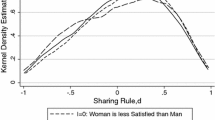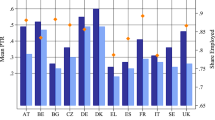Abstract
I give an empirical answer to whether the sharing patterns of household consumption of participating and nonparticipating wives differ. I use the basic collective model conditioned on female participation to identify the sharing patterns. Using Spanish data, I test the model assumptions and I find significant differences. Nonparticipating wives get larger transfers from their husbands than participating wives. However, while participating wives with at least an equal total share keep a part of their increase in wages for their own consumption, nonparticipating wives cannot benefit from having better labor opportunities. These results complement evidence about intrahousehold distribution of home time.
Similar content being viewed by others
References
Bloemen HG (2004) An empirical model of collective household labour supply with nonparticipation. Tinbergen Institute discussion papers 04-010/3. Tinbergen Institute, Amsterdam
Blundell R, Chiappori PA, Magnac T, Meghir C (2007) Collective labor supply: heterogeneity and nonparticipation. Rev Econ Stud 74(2):417–445
Bourguignon F, Browning M, Chiappori PA (2006) Efficient intra-household allocations and distribution factors: implications and identification. Working paper 2006-02. Centre for Applied Microeconometrics, University of Copenhagen
Browning M, Chiappori PA (1998) Efficient intra-household allocations: a general characterization and empirical test. Econometrica 66(6):1241–1278
Browning M, Gørtz M (2007) Spending time and money within the household. Mimeo. University of Oxford and AKF, Institute of Local Government Studies, Denmark
Browning M, Meghir C (1991) The effects of male and female labor supply on commodity demands. Econometrica 59(4):925–951
Browning M, Bourguignon F, Chiappori PA, Lechene V (1994) Income and outcomes: a structural model of intrahousehold allocation. J Polit Econ 102(6):1067–1096
Browning M, Chiappori PA, Lewbel A (2006) Estimating consumption economies of scale, adult equivalence scales, and household bargaining power. Economics series working papers 289, Department of Economics, University of Oxford
Carrasco R, Zamora B (2007) The causal effect of female labour participation on household consumption. Evidence from Spanish data. Mimeo. University Jaume I, Castellón
Chiappori PA (1988) Rational household labor supply. Econometrica 56(1):63–90
Chiappori PA (1992) Collective labor supply and welfare. J Polit Econ 100(3):437–467
Deaton A, Ruiz-Castillo J, Thomas D (1989) The influence of household composition on household expenditure: theory and spanish evidence. J Polit Econ 97(1):179–200
Donni O (2003) Collective household labor supply: nonparticipation and income taxation. J Public Econ 87(5–6):1179–1198
Donni O (2007) Collective female labor supply: theory and application. Econ J 117(516):94–119
Fernandez C, Sevilla-Sanz A (2006) Social norms and household time allocation. Economics series working papers 291, Department of Economics, University of Oxford
Hourriez JM (2005) Estimation of a collective model of labor supply with female nonparticipation. Mimeo. CREST-INSEE, France
Laat JJ, Sevilla-Sanz A (2007) Working women, men’s home time and lowest low fertility. Economics series working papers 308, Department of Economics, University of Oxford
Lee DH, Schaninger CM (2003) Attitudinal and consumption differences among traditional and nontraditional childless couple household. J Consum Behav 2(3):248–268
Maddala GS (1983) Limited dependent and qualitative variables in econometrics, 1st edn. Cambridge University Press, New York
McElroy MB (1990) The Empirical content of nash-bargained household behavior. J Hum Resour 25(4):561–583
Meghir C, Robin JM (1992) Frecuency of purchase and the estimation of demand systems. J Econom 53:53–85
Peña D, Ruiz-Castillo J (1998) Estimating food and drinks household expenditures in the presence of bulk purchases. J Bus Econ Statist 16(3):292–303
Schaninger CM, Putrevu S (2006) Dual spousal work involvement: an alternative method to classify household/families. Acad Mark Sci Rev 2006(8):1–21
Wooldridge JM (2002) Econometric analysis of cross section and panel data, 1st edn. MIT, Cambridge
Author information
Authors and Affiliations
Corresponding author
Additional information
Responsible editor: Deborah Cobb-Clark
Rights and permissions
About this article
Cite this article
Zamora, B. Does female participation affect the sharing rule?. J Popul Econ 24, 47–83 (2011). https://doi.org/10.1007/s00148-008-0208-5
Received:
Accepted:
Published:
Issue Date:
DOI: https://doi.org/10.1007/s00148-008-0208-5




